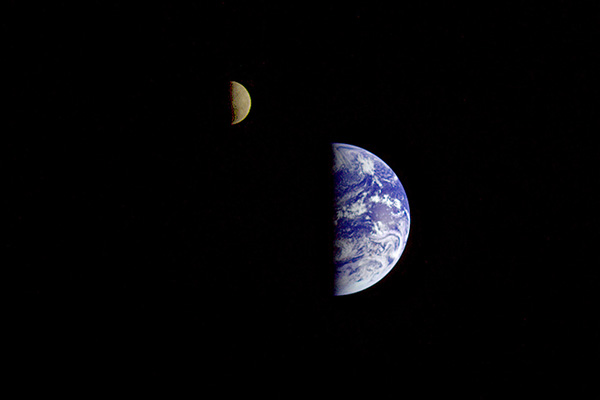What is the “mini moon” that is now orbiting Earth? Astrophysicist explains small cosmic guest — and the bigger one that’s on the horizon
For two months, a small asteroid will join Earth’s orbit, a common yet little known occurrence. However, a Northeastern astrophysicist has her eyes on another asteroid that will be a much closer call for the planet.

For the next two months, Earth will have a cosmic guest. A so-called “mini moon” will join our actual moon in circling the planet until Nov. 25.
What exactly is the mini moon? It’s actually a small asteroid –– only 33 meters across, the size of a bus and 300,000 times smaller than Earth’s — that has temporarily entered Earth’s gravitational pull, says Jacqueline McCleary, an assistant professor of physics at Northeastern University.
“Perturbations — little kicks from Jupiter’s gravity, the sun’s gravity, Earth’s gravity — can sometimes knock an object a little bit closer so that it falls in towards the Earth,” McCleary explains. “For an object to be orbiting or be a satellite, it would have to be traveling at a speed lower than the escape velocity.”
“So, technically, it will be captured by the Earth’s gravitational potential,” she adds. “But instead of doing a complete orbit like a regular moon, it’s more going to be deflected and then come back in and then kicked back out again and return to more or less its previous orbit around the sun.”
This mini moon, asteroid 2024 PT5, came from the Arjuna asteroid belt, a group of small asteroids that were discovered only in the last 30 years, and it is set to return to Earth’s orbit in 2055. McCleary says these moonlets are actually quite common.
“About every 10 to 20 years an object probably from the Arjuna asteroid belt falls into the gravitational influence of the Earth-moon system and has its orbit altered enough that technically it can be considered a satellite of the Earth as opposed to just moving in a heliocentric orbit,” McCleary says.

Unfortunately, for those hoping to catch a glimpse of the mini moon, it’s too small and dark to be seen with the naked eye. Unless you have access to a powerful telescope, Earth’s little cosmic guest will be out of sight for most people.
However, skygazers will be able to catch a close glimpse of another asteroid before too long, though it might be a little too close for comfort. In 2029, Apophis, a much larger asteroid, will closely approach Earth and serve as a reminder that not every asteroid that comes Earth’s way is as small or harmless as the mini moon.
Named after the ancient Egyptian serpent demon and “Lord of Chaos” Apep, the asteroid measures 1,100 feet or 355 meters. In comparison, the asteroid that exploded over a Siberian forest in 1908, the largest impact event in recorded history, was smaller than 100 meters in diameter. The asteroid that wiped out the dinosaurs was about 10 kilometers across.
Featured Posts
Don’t start planning for the end of the world though. Since its discovery in 2004, a subsequent fly-by of the asteroid in 2021 helped “eliminate it as a serious impact risk,” McCleary says. And a recent study confirmed that the chances of that changing in a way that would be disastrous for Earth are less than one in 2 billion.
“Never say never,” McCleary is careful to note, but “though that is not the same as zero odds, it’s effectively zero odds.” It will still be a close call, close enough to be visible to the naked eye, “no binoculars or telescope needed.”
“If I were to ballpark it, this is a once in a century event for an object of Apophis’ size to come so close to the Earth,” McCleary says. “It’s not often that we as a planet experience an immediate existential threat. It’s definitely going to capture everyone’s attention.”
NASA scientists are already taking full advantage of this rare kind of close contact with an asteroid of Apophis’ size. In the leadup to Apophis’ close fly-by of Earth, NASA will send OSIRIS-Rex, a spacecraft designed for asteroid study and sample collection, to intercept Apophis and orbit the asteroid for 18 months.
The information gathered from Apophis could help NASA deflect asteroids that pose a real risk to Earth in the future, McCleary says. In 2022, NASA deployed its Double Asteroid Redirection Test, or DART, to ascertain whether they could redirect the orbit of large asteroids by firing a satellite at them. The test was conducted on Dimorphos, a moonlet of asteroid Didymos, which together made up a double asteroid system.
To deflect an asteroid the size of Apophis would require “a much bigger impactor,” McCleary says, but it could, in theory, work.
“The way that orbital mechanics works, as long as you deflect an object off course, you don’t have to knock it out of the Solar System, just alter its trajectory so that instead of falling instead of falling into the Earth’s gravitational well, it just skims it and bypasses it,” McCleary says. “This OSIRIS-Rex reboot will help us plan out what a kinetic deflector like DART would need to look like in the future.”











